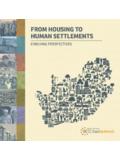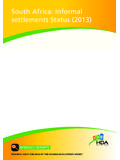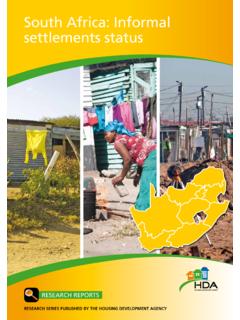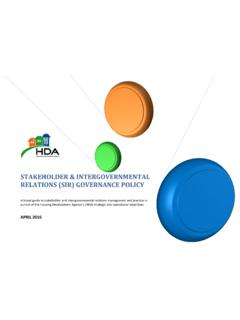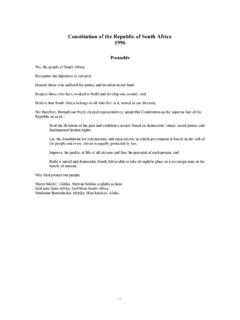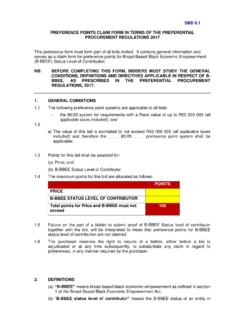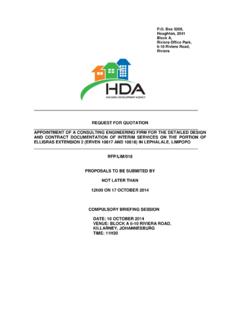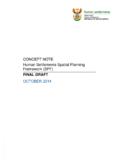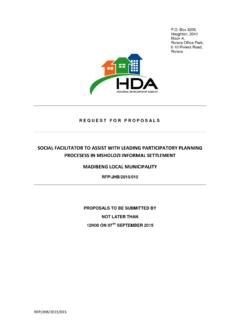Transcription of National Human Settlements Land Indices - The HDA
1 National Human Settlements land IndicesAN OVERVIEWA ccelerating the development of sustainable Human Settlements through land assembly, building and property acquisitions, and project management and support servicesHistorically, the management of South African Human Settlements has been driven by the ideology of separate development rather than by a concern to create a healthy, viable urban environment. This legacy has produced a complex set of spatial and physical problems created by the previous apartheid planning system resulting in ineffi cient city functioning in a context of high rates of unemployment, increasing rates of urbanisation, backlogs in the provision of basic services and a wide range of social problems.
2 Since 1994 much progress has been made in reversing the tide of poverty and homelessness left in the wake of apartheid. Underpinned by the new constitution, the White Paper of 1994, the Housing Act, the Housing Code and the Comprehensive Plan for the Development of Sustainable Human Settlements / Breaking New Ground strategy of 2004, a new direction has been set towards a landscape where all citizens can enjoy a certain quality of life, access to services and a secure roof over their heads. Yet there remains a long journey ahead, with a National backlog of over 2 million housing units and compelling evidence that structural poverty, a key apartheid legacy, is deepening. A thorough analysis of the housing development value-chain and the investigation of major bottlenecks in the development of sustainable Human Settlements revealed that the acquisition of land is a major obstacle.
3 The acquisition of well-located or habitable state owned land for Human Settlements has proved to be complex, ineffi cient and debilitating for the intended social objectives. Problems of alignment between the three spheres of government in terms of divergent legal frameworks, different operational imperatives, ownership and asset management fragmentations as well as complex division of powers and functions, result in the chronic failure to acquire well-located or habitable state owned land to develop sustainable Human Settlements . Houses are built on land without consideration of land habitability and the poor still end up on the periphery far from transport, amenities, work opportunities, etc. These challenges are further compounded by the fact that no one knows who owns the land or who has rights to it AND no-one knows where the land distribution of state land in South Africa.
4 Type of land Hectares SA land and water cover million State land million With the strong emphasis now on transforming spatial arrangements and spatial governance, a renewed effort is needed to ensure that National , provincial and local government work together in reshaping the built environment to achieve a smarter and fairer development of Human Settlements . Accordingly, the Housing Development Agency (HDA) was established as a special purpose vehicle to assist in the expediting of housing development and delivery in South Africa through land identifi cation, acquisition and preparation for Human Settlements . The HDA s mandate is provided by the Housing Development Agency, Act 23 of 2008, which in Section 7 states that the HDA must:(1)(b) develop strategic plans with regard to the identifi cation and acquisition of state, privately and communal owned land which is suitable for residential and community development;(1)(d) monitor progress of the development of land and landed property acquired for the purposes of creating sustainable Human Settlements ; and(2) (a) ensure that residential and community developments are sustainable, viable and appropriately NaHSLI?
5 In view of the nature of the land identifi cation and acquisition function of the HDA, it is necessary to apply pre-determined criteria as an HDA strategic fi lter to guide and inform land identifi cation and acquisition. Accordingly, the HDA is developing the National Human Settlements land Indices (NaHSLI) which is an executive analytical tool to facilitate and guide the formulation of planning alternatives that optimise utilisation of scarce resources and reduce the negative impact of land and property development on the environment. NaHSLI seeks to provide an innovative way of addressing the multifaceted challenges of sustainable Human Settlements and make better informed decisions on the identifi cation and acquisition of state-owned, communal and private land .
6 NaHSLI is guided by Four Principles The Natural Environment, for geotechnical conditions, forestry, biodiversity, climate change, etc. The Regulatory Environment, for land tenure, land use, land value, etc. The Structural Environment, for transport network, location of services and utilities, etc. The Social Environment, for population, employment, migration, health, principles of the natural environment, regulatory environment, structural environment and social environment within NaHSLI will assist in refocusing attention to spatial planning as a tool for the creation of sustainable Human Settlements and underline the importance of spatial data and information in the effectiveness of this process.
7 Ultimately, the intention is for NaHSLI to assert the harmony with the natural environment and balance economic and social development with the needs of South is NaHSLI?The overall aim of NaHSLI is to provide a scale overview of the contextual factors that impact the creation of sustainable Human Settlements by answering the following questions: Where is suitable land ? Where is available land ? Where is accessible land ? Where is livelihood land ? Where is well-located or habitable land ?The strategic vision for NaHSLI is for it to be used by all units of government and the general public to provide the textual and visual spatial information, as well as the results of spatial analysis, to aid discussions and deliberations in the planning process.
8 The tool is a key asset that serves the people of South Africa by assisting in spatial planning and the making of plans that are in harmony with development, the environment and society, thereby ensuring the effi cient and effective creation of sustainable Human Settlements . The objectives of the NaHSLI are to: Identify habitable land and non-habitable land Identify the risk-prone areas Inform on where could Human Settlements be best located Inform on the development potential of the habitable landFigure 4: Objectives of NaHSLI The development of NaHSLI was made possible through the dedication, commitment and the forging of relationships with key stakeholders such as the Council for Geoscience (CGS), Department of Agriculture, Fisheries and Forestry (DAFF), ESKOM, Department of Rural Development and land Reform (DRDLR) and City of Johannesburg.
9 NaHSLI geospatial data infrastructure was designed and developed based on the spatial data infrastructure act (Act no 54 of 2003), the spatial data standards (STANSA) and the compilation of Metadata. This provides for NaHSLI to be a robust and credible tool whilst ensuring data reliability, currency and encompasses land and property details, ownership and transaction details, administrative boundaries; topographic data in the form of slope, geotechnical, transport network and location of services and utilities; land use data such as residential, commercial, industrial, agriculture etc.; thematic data such as soil types, forestry, biodiversity, climate and land forms; and social data such as population, migration and health, etc.
10 NaHSLI has the added functions of integrating all these datasets and computing different Indices such as the land suitability index (LSUi) land availability index (LAVi), land accessibility index (LACi) and land livelihood index (LLIi) based on weighted indicators to determine whether the land is land Index, HLAi = LSUi + LAVi + LACi + LLIiHow we use NaHSLI?NaHSLI s conceptual framework has been developed to understand and analyse the potential of different localities to support sustainable development. The framework consists of the four principles, namely Natural Environment, Regulatory Environment, Structural Environment and Social Environment. These are interrelated and co-dependent and build on the aim of supporting sustainable Settlements through identifying Suitable, Available, Accessible and Livelihood Framework of the National Human Settlements land Indices (NaHSLI)Habitable land Index, HLAi=LSUi+LAVi+LACi+LLIiNatural EnvironmentRegulatory EnvironmentSocial EnvironmentStructural EnvironmentLand Sustainability Index, LSUi= Geotechnical Hazard Index + Environmental Risk Index + land Capacity Index + Ecological Infrastructure and Biodiversity Assets Index + Climate Change Adaptation IndexAuthor.
